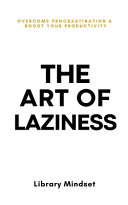

The book begins by challenging the conventional perception of laziness as a negative trait. It posits that laziness can be a catalyst for innovation and efficiency. By allowing oneself to embrace laziness, individuals can prioritize their energy towards tasks that truly matter, thus fostering creativity and problem-solving. The author argues that many successful inventions and ideas stem from a desire to simplify tasks, which is often born from a lazy mindset. This concept encourages readers to rethink their approach to work and productivity, suggesting that taking breaks and allowing for downtime can lead to greater achievements.
Continue readingIn this section, the author emphasizes the importance of downtime for mental and physical health. The book presents research that shows how rest periods can enhance cognitive function and creativity. It encourages readers to integrate regular breaks into their routines, arguing that these moments of inactivity can lead to bursts of productivity and innovation. The author shares anecdotes of famous figures who prioritized rest and how this contributed to their success. This idea reinforces the notion that working harder is not always synonymous with working smarter.
Continue readingA core theme of the book is the distinction between being busy and being efficient. The author critiques the culture of busyness that pervades modern society, suggesting that simply filling one’s schedule does not equate to meaningful work. Instead, the book advocates for a focus on efficiency—doing less but achieving more. It provides practical strategies for identifying and eliminating time-wasting activities, allowing readers to concentrate on high-impact tasks. This reorientation towards efficiency can lead to a more fulfilling and productive life.
Continue readingThe book discusses the role of mindfulness in enhancing productivity and creativity. By being present in the moment and fully engaging with tasks, individuals can find greater satisfaction and effectiveness in their work. The author provides techniques for practicing mindfulness, such as meditation and conscious breathing, which can help reduce stress and improve focus. This idea connects laziness with a more intentional approach to life, where individuals are encouraged to slow down and appreciate their surroundings, ultimately leading to greater clarity and productivity.
Continue readingAnother significant idea in the book is the debunking of multitasking as an effective strategy. The author cites research showing that multitasking can lead to decreased productivity and increased errors. Instead, the book promotes single-tasking—focusing on one task at a time to improve quality and efficiency. This approach aligns with the overall theme of laziness, as it encourages individuals to do less but do it well. The author provides tips on how to implement single-tasking in daily life, which can lead to a more organized and less stressful work environment.
Continue readingThe idea of embracing imperfection is presented as a way to alleviate the pressure of perfectionism that often hinders productivity. The author argues that striving for perfection can lead to procrastination and burnout. Instead, the book encourages readers to accept that mistakes are part of the learning process and that aiming for 'good enough' can often be more productive. This shift in mindset allows individuals to take action without the fear of failure, fostering a more creative and innovative approach to work and life.
Continue readingThe final idea revolves around the concept of designing one's environment to support a lazy, yet productive lifestyle. The author suggests that physical spaces can influence behavior and productivity. By creating a workspace that minimizes distractions and promotes comfort, individuals can enhance their ability to focus and be productive. The book provides practical tips on decluttering, organizing, and optimizing workspaces to support a lazy approach that ultimately leads to greater efficiency and satisfaction.
Continue reading